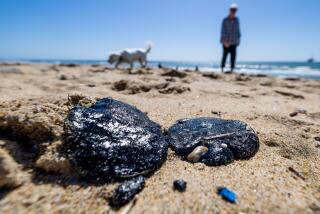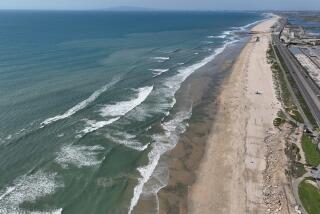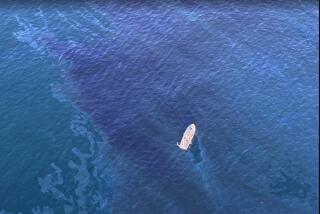Experts at a Loss to Tell Where the Oil Will Go : Research: Despite years of studying such disasters, oceanographers still donât know what effect the wind and tides will have on the Huntington Beach spill.
Despite years of research into the dynamics of oil spills, Southern California oceanographers are at a loss to predict the exact fate of the large slick off Huntington Beach because they donât know enough about their own back yard.
âThe state of scientific knowledge is completely inadequateâ as to the complex pattern of currents along the Southern California coastline, said Clinton Winant, director of the Center for Coastal Studies at UC San Diegoâs Scripps Institution of Oceanography.
Last summer Winant co-authored a report for the National Research Council that warned the effects of an oil spill here would be hard to predict because of the lack of detailed studies of the California coastline.
Ironically, more effort has been invested in studying areas such as the Gulf of Alaska than Southern California because the coastal waters here were believed to be so benign to ships. That changed somewhat Wednesday night when the oil tanker American Trader ripped open and began dumping Alaskan crude into the sea off Huntington Beach.
The state of the art of oil slick prediction is so precarious for Southern California that Winant--one of the top experts in his field--could not come even close to foretelling the fate of the slick.
âIf it hits shore, it could be anywhere from Ensenada (Mexico) to Santa Barbara,â he said. âOr it could go out to sea and never be heard from again.â
A major study by the National Academy of Sciences in 1985 concluded that major slicks differ so much from one area to another that âthere is no one universal model that will generally yield predictions that are realistic or undistorted.â
But in recent years oceanographers have developed a fairly comprehensive understanding of the physical dynamics involved when oil is spilled on the ocean, so experts were able to at least say something about the fate of the large slick.
As with most oil spills, possibly as much as two-thirds of this oil will evaporate, and âobviously, the slickâs going to move,â said Glen Watabayashi, an oceanographer with the National Oceanic and Atmospheric Administration in Seattle and a specialist in the interaction between the ocean and oil spills.
He said the dominant force on the slick will be the wind, which was blowing it out to sea Thursday.
âThe rule of thumb is that the slick will move about 3% of the wind speed,â Watabayashi said. But currents will also play a role in the fate of the slick, and, as Winant pointed out, those currents are not well understood.
If the wind increases, it will drive the slick faster, but higher winds will also cause the ocean surface to grow choppy.
âIf that happens, the oil will start to weather faster,â Watabayashi said. âIt will absorb water and it will look more like tar. Eventually, if it gets real rough, the slick will start to break apart and you will get tar balls,â which tend to sink to the bottom.
âThe bigger the waves, the faster it (the slick) will break up,â he added. The winds also affect the currents, making the picture far more complicated.
And that, Winant said, is particularly frustrating because more research would have prepared California better for dealing with the spill.
The need for more information, he said, âis something that the federal government knows about.â
He cited one example of the consequences of an inadequate understanding of the California coastal waters.
In 1984, he said, when knowledge of Northern Californiaâs coast was more limited than it is today, an explosion occurred aboard the Puerto Rican, a tanker carrying 92,000 barrels of refined oil out of San Francisco Bay.
In order to minimize damage from the spill, the leaking vessel was towed offshore to the southwest, and for five days the oil traveled steadily away from land. On the morning of the sixth day, however, response teams had trouble finding the spill. The currents had reversed and, by midday, the oil washed across one of Northern Californiaâs prized beaches at Bodega Bay.
Since the 1984 spill, Winant said, studies of currents off San Francisco have been completed that explain what happened to the spill. But no such analyses have been done for Southern California, he added.
More to Read
Sign up for Essential California
The most important California stories and recommendations in your inbox every morning.
You may occasionally receive promotional content from the Los Angeles Times.










